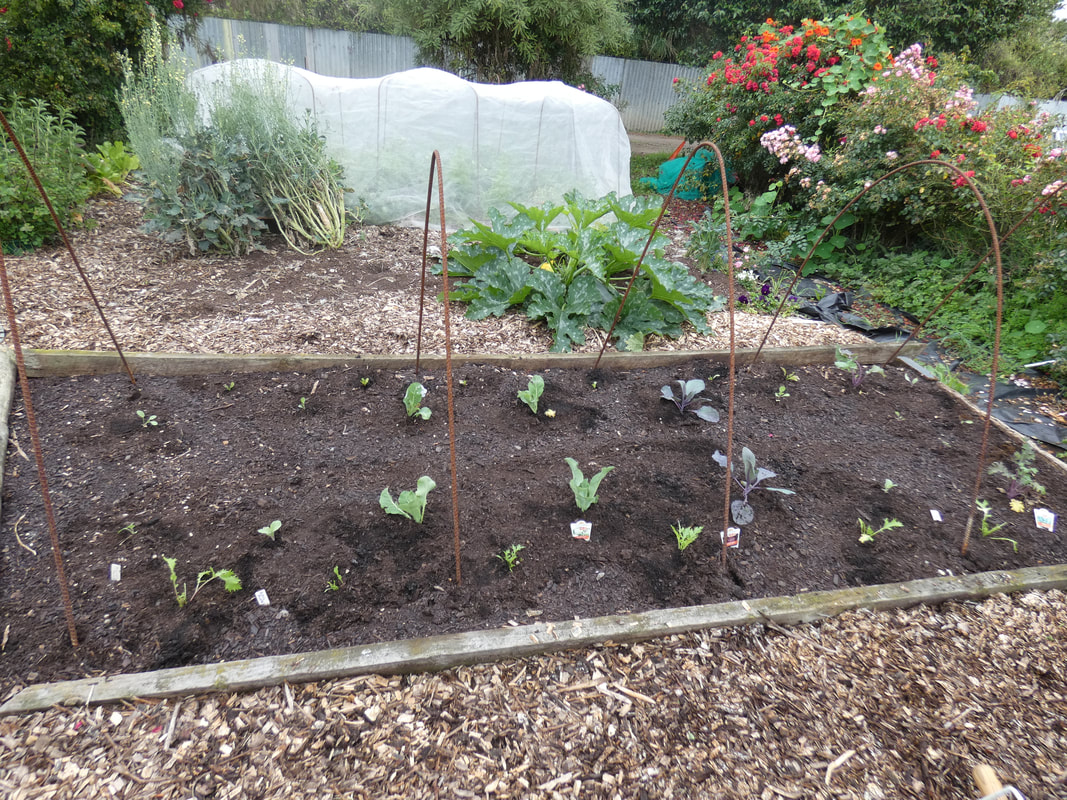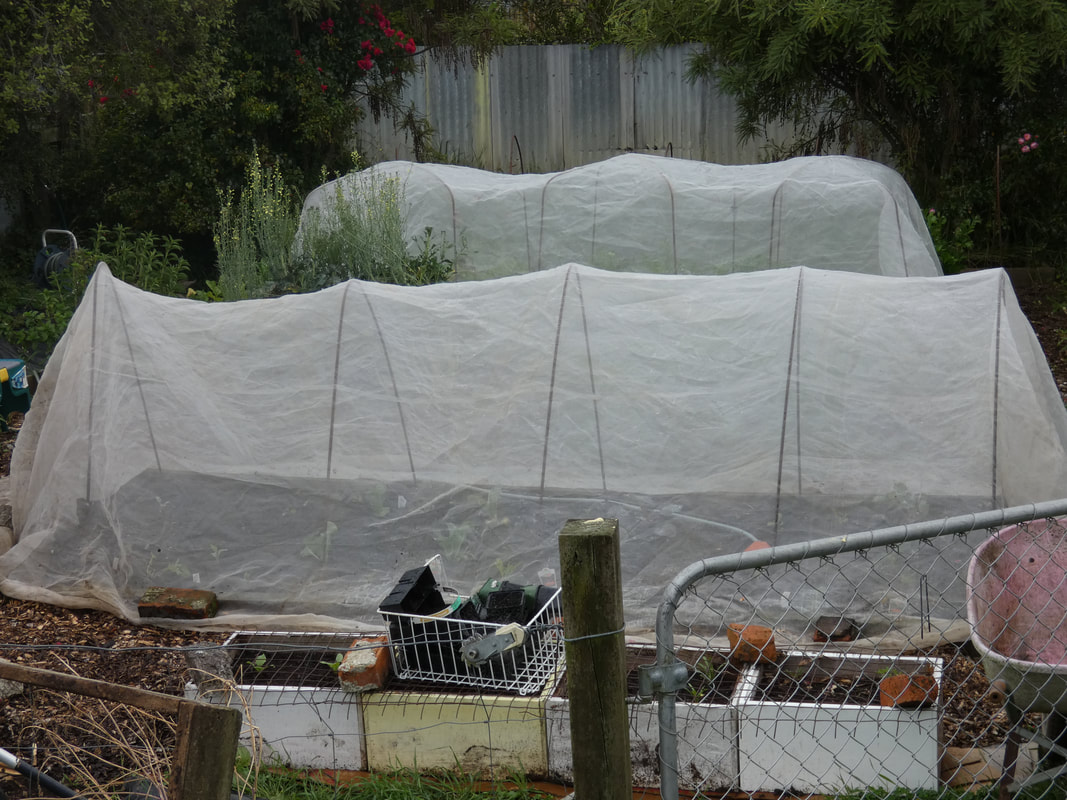This week, according to the moon calendar, is the perfect time to plant above-ground growing crops, and this month is the perfect time to get winter brassicas in, so today I did just that. In past years I have found that I needed to get them in by February to enjoy harvestable crops by winter - brassicas become essentially dormant when temps drop below 10C and if they haven't had time to get to a good size before then, they sit small in the garden, then bolt when the weather warms up again in spring. However, since I started using Wondermesh over my brassica crops (to keep off white butterflies and diamondback moths), I've found that the microclimate it creates encourages faster growth in my plants, so March works well. Folk in other parts of the country may need to plant earlier or be able to plant later.
I don't stick strictly to the moon calendar for planting, but try to use it when I can; I've seen the difference it can make in crops such as the dwarf beans and corn crops I experimented with. The main principal in the moon calendar planting plan is that as the moon is waxing (getting bigger) is the best time for planting crops that grow mostly above ground, due to the "drawing up" effect of the moon on plant sap. I've also noticed the tendency of the weather to be more unsettled during this period - today it's turned cloudy and rainy, which is also great for planting as the seedlings get a bit of time to settle in before they are exposed to hotter days. The weather is also often likely to be more unsettled as we approach the autumn equinox on March 22nd - it's not usually as profoundly so as during the spring equinox, but still, good to get these plants in now.
I don't stick strictly to the moon calendar for planting, but try to use it when I can; I've seen the difference it can make in crops such as the dwarf beans and corn crops I experimented with. The main principal in the moon calendar planting plan is that as the moon is waxing (getting bigger) is the best time for planting crops that grow mostly above ground, due to the "drawing up" effect of the moon on plant sap. I've also noticed the tendency of the weather to be more unsettled during this period - today it's turned cloudy and rainy, which is also great for planting as the seedlings get a bit of time to settle in before they are exposed to hotter days. The weather is also often likely to be more unsettled as we approach the autumn equinox on March 22nd - it's not usually as profoundly so as during the spring equinox, but still, good to get these plants in now.
So, today I have planted the following in this garden bed, which I created a couple of weeks ago by laying down cardboard and covering with 2-3 inches of compost. When planting, I've used a trowel to break through the now-soggy cardboard so the plants can root down into the soil below as well.
2x Broccoli - Marathon
2x Purple sprouting Broccoli
4x Cauliflower - mini white
2x Red Cabbage
2x Cabbage - Derby Day (green)
4x Russian Red kale
2x purple Kohl Rabi
2x green Kohl Rabi
6x Mizuna down one side of the bed
6x Rocket down the other side of the bed
In the open space along the middle of the bed I've sown some seeds of Rat-tailed Radish in the middle, and Detroit Dark Red beetroot (2-3 to a hole). These should grow quickly and be harvested before the brassicas get very big - the raddishes will be grown for their seed pods, though by then I'd need the nets off so the flowers are pollinated (which just occurred to me as I am typing, so we'll see about that).
2x Broccoli - Marathon
2x Purple sprouting Broccoli
4x Cauliflower - mini white
2x Red Cabbage
2x Cabbage - Derby Day (green)
4x Russian Red kale
2x purple Kohl Rabi
2x green Kohl Rabi
6x Mizuna down one side of the bed
6x Rocket down the other side of the bed
In the open space along the middle of the bed I've sown some seeds of Rat-tailed Radish in the middle, and Detroit Dark Red beetroot (2-3 to a hole). These should grow quickly and be harvested before the brassicas get very big - the raddishes will be grown for their seed pods, though by then I'd need the nets off so the flowers are pollinated (which just occurred to me as I am typing, so we'll see about that).
As you can see in the below slideshow, the seedlings vary in size. Most of the smaller ones were sown in my greenhouse in January. They've been slower to grow this year than ever; not sure what that's about. The bigger ones were some additional seedlings I purchased because some of my seeds didn't germinate. I have grown three times as many of everything as planted here - equal amounts are for my daughter who is starting a garden, and a local friend who is too. Honestly, I would have purchased more seedlings, but it's been difficult to find any of the varieties I actually want, or find ones in good enough condition that I'd pay for them.
After giving the bed a good watering, I have covered it in Wondermesh. This past pic taken from inside as it's now raining.
I will also sow more brassica seeds this week; it's too late to sow them for outdoor planting, so these ones will be to grow in beds in my greenhouse. I think I'll do more broccoli, and perhaps just a couple each of cauli and cabbage. Maybe some more mizuna and rocket too. I don't sow or plant brussel sprouts at this time of year - to get a decent harvest here, they need to be sown in December and planted out in January.



 RSS Feed
RSS Feed
